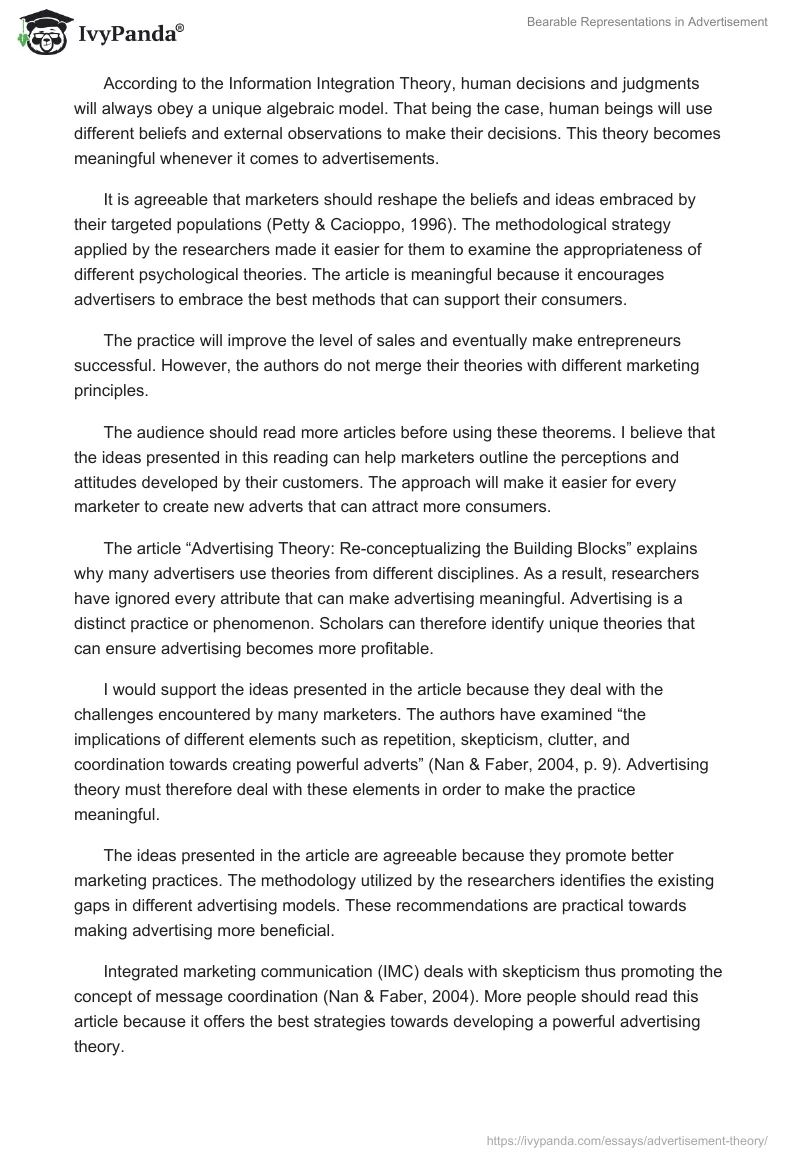According to Weilbacher (2003, p. 231), “many advertisers have ignored the theories and ideas supported by different cognitive psychologists”. Scholars and analysts believe that adverts should widen the people’s ideas about every existing product. The article is appreciable because it explains why advertising should create bearable representations. This practice is appropriate because it produces the targeted goals.
The methodological inquiry employed by the researcher makes it possible to understand why advertising should become meaningful and informative. Marketers tend to develop numerous assumptions thus making it impossible for them to design the best communication approaches. The inquiry manages to analyze the disasters associated with most of these assumptions.
This “is true because consumer behaviors are not rational choices” (Weilacher, 2003, p. 232). The practical implications of these ideas and suggestions are undeniable. Many advertisers are unable to achieve their goals because of the above assumptions. Marketers should use the ideas presented in this article in order to create the best images for their brands.
The practice will ensure such brands become desirable and acceptable by different consumers. The “agreeable fact is that consumers will process every advert in an instantaneous manner” (Weilacher, 2003, p. 231). However, I strongly believe that new studies are required in order to place this practice within Human Behavioral Psychology (HBS).
The article “Attitudes and Persuasion” by Petty and Cacioppo describes how human beings process different ideas and information. Cognitive Dissonance Theory is relevant because it makes it easier for scholars to investigate two elements at a particular time. This theory explains how individuals tend to make spectacular decisions whenever dealing with various issues.
According to the Information Integration Theory, human decisions and judgments will always obey a unique algebraic model. That being the case, human beings will use different beliefs and external observations to make their decisions. This theory becomes meaningful whenever it comes to advertisements.
It is agreeable that marketers should reshape the beliefs and ideas embraced by their targeted populations (Petty & Cacioppo, 1996). The methodological strategy applied by the researchers made it easier for them to examine the appropriateness of different psychological theories. The article is meaningful because it encourages advertisers to embrace the best methods that can support their consumers.
The practice will improve the level of sales and eventually make entrepreneurs successful. However, the authors do not merge their theories with different marketing principles.
The audience should read more articles before using these theorems. I believe that the ideas presented in this reading can help marketers outline the perceptions and attitudes developed by their customers. The approach will make it easier for every marketer to create new adverts that can attract more consumers.
The article “Advertising Theory: Re-conceptualizing the Building Blocks” explains why many advertisers use theories from different disciplines. As a result, researchers have ignored every attribute that can make advertising meaningful. Advertising is a distinct practice or phenomenon. Scholars can therefore identify unique theories that can ensure advertising becomes more profitable.
I would support the ideas presented in the article because they deal with the challenges encountered by many marketers. The authors have examined “the implications of different elements such as repetition, skepticism, clutter, and coordination towards creating powerful adverts” (Nan & Faber, 2004, p. 9). Advertising theory must therefore deal with these elements in order to make the practice meaningful.
The ideas presented in the article are agreeable because they promote better marketing practices. The methodology utilized by the researchers identifies the existing gaps in different advertising models. These recommendations are practical towards making advertising more beneficial.
Integrated marketing communication (IMC) deals with skepticism thus promoting the concept of message coordination (Nan & Faber, 2004). More people should read this article because it offers the best strategies towards developing a powerful advertising theory.
Marketers have always used new advertising models. The important thing is for advertisers to understand how the world is changing. This strategy will make it possible for them to create better adverts that can attract more consumers. The author explains why the “theory of brands is relevant whenever formulating new marketing concepts” (Hall, 2007, p. 64).
I strongly support this argument because the nature of a brand always determines the best advertising strategy. Many consumers are not ready to purchase defective products. The methodological design embraced by the author identifies different models that have made many companies successful. Every advertising model can change depending on the expectations of the targeted consumers.
Marketers must produce better products in order to fulfill the needs of their customers. An appropriate scientific method will analyze the assumptions and views formed by different consumers. This approach will result in better theories that can make advertising more effective.
The concepts presented in this article are applicable in different business activities. According to the article, “marketers should be practical in order identify the most effective drivers for their products” (Hall, 2007, p. 70). The theories and methods analyzed in this article are relevant because they can help advertisers attract more customers.
Reference List
Hall, M. (2007). How Advertising Works: New Steps on the Advertising Timeline. Readings in Account Planning, 1(1), 57-70.
Nan, X., & Faber, R. (2004). Advertising Theory: Re-conceptualizing the Building Blocks. Sage, 4(1), 7-30.
Petty, R., & Cacioppo, J. (1996). Attitudes and Persuasion: Cognitive Dissonance Theory. Motivational Approaches, 1(1), 136-206.
Weilacher, W. (2003). Point of View: How Advertising Affects Consumers. Journal of Advertising Research, 1(1), 230-234.


